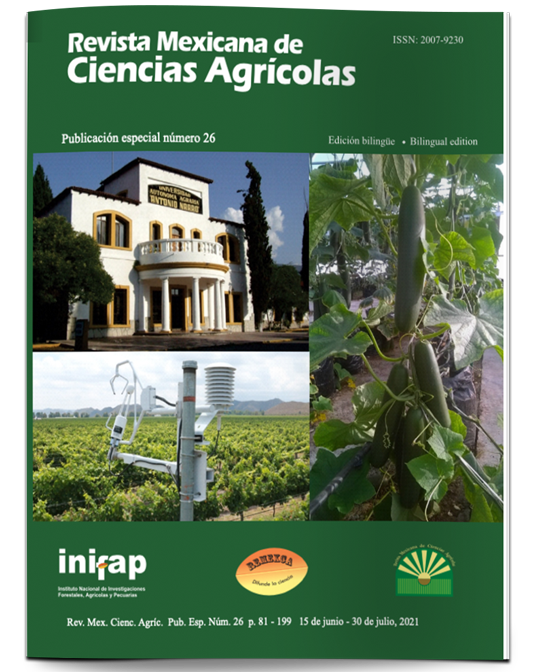Impact of different fertilizers on soil solution and tomato growth
DOI:
https://doi.org/10.29312/remexca.v0i26.2941Keywords:
Solanum lycopersicum L., anions, calcisols, cations, mineral nutritionAbstract
Soil solution is a complex and open system that has inputs and outputs of energy, this study was carried out to determine the impact of different types of fertilizers on the composition of the soil solution and the accumulation of biomass in tomato plants. Tomato plants cultivated in greenhouse in pots with calcareous soil and forest soil were used to apply three types of fertilizers: Steiner solution, solid fertilizers and vermicompost tea. Concentrations of NO3-, K+, Ca2+, Mg2+, Na+ and SO42- in the soil solution increased over time, registering higher ion concentration values in the solid fertilizer (625, 183, 374, 70, 49 and 161 mg L-1, respectively) and in the Steiner solution (500, 177, 363, 65, 69 and 235 mg L-1). The highest concentrations of ions in the soil solution coincided with the largest accumulation of biomass, 3 938 and 4 546 g plant1 in the solid fertilizer and the Steiner solution, respectively. In contrast, in the soil solution of the vermicompost tea, except for Na+, there were lower ion concentrations (94, 63, 118, 28, 75 and 98 mg L-1) and a lower accumulation of biomass, with an average of 1 355 g plant-1. The Steiner solution and solid fertilizers treatments had the highest average yield values, with 3 637 and 2 712 g plant-1, respectively. This result indicates that the form of application and source of the fertilizer influences the soil solution.
Downloads
Downloads
Published
How to Cite
Issue
Section
License
Copyright (c) 2021 Revista Mexicana de Ciencias Agrícolas

This work is licensed under a Creative Commons Attribution-NonCommercial 4.0 International License.
The authors who publish in Revista Mexicana de Ciencias Agrícolas accept the following conditions:
In accordance with copyright laws, Revista Mexicana de Ciencias Agrícolas recognizes and respects the authors’ moral right and ownership of property rights which will be transferred to the journal for dissemination in open access. Invariably, all the authors have to sign a letter of transfer of property rights and of originality of the article to Instituto Nacional de Investigaciones Forestales, Agrícolas y Pecuarias (INIFAP) [National Institute of Forestry, Agricultural and Livestock Research]. The author(s) must pay a fee for the reception of articles before proceeding to editorial review.
All the texts published by Revista Mexicana de Ciencias Agrícolas —with no exception— are distributed under a Creative Commons License Attribution-NonCommercial 4.0 International (CC BY-NC 4.0), which allows third parties to use the publication as long as the work’s authorship and its first publication in this journal are mentioned.
The author(s) can enter into independent and additional contractual agreements for the nonexclusive distribution of the version of the article published in Revista Mexicana de Ciencias Agrícolas (for example include it into an institutional repository or publish it in a book) as long as it is clearly and explicitly indicated that the work was published for the first time in Revista Mexicana de Ciencias Agrícolas.
For all the above, the authors shall send the Letter-transfer of Property Rights for the first publication duly filled in and signed by the author(s). This form must be sent as a PDF file to: revista_atm@yahoo.com.mx; cienciasagricola@inifap.gob.mx; remexca2017@gmail.
This work is licensed under a Creative Commons Attribution-Noncommercial 4.0 International license.



